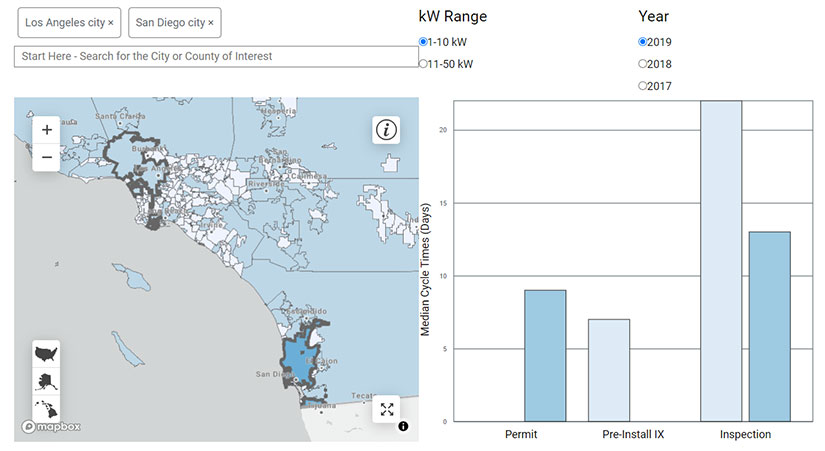NREL's New Solar TRACE Tool Adds Transparency to Permitting, Inspection, and Interconnection Nationwide
Distributed solar photovoltaic prices have plummeted over the past decade, but non-equipment “soft costs” like permitting, inspection, and interconnection (PII) remain stubbornly high. PII review and approval processes associated with the 20,000 distinct jurisdictions and 3,000 utilities can sometimes add weeks or months to the installation process along with higher install costs passed to homeowners. These longer wait times can also increase the risks of cancellations, thereby passing even higher costs to successful sales.
In partnership with the solar industry, the National Renewable Energy Laboratory (NREL) developed the Solar Time-based Residential Analytics and Cycle time Estimator (Solar TRACE), an online tool to increase transparency into PII processes, requirements, and overall adoption cycle times nationwide. Users will be able to compare the timelines and requirements of PII for any jurisdiction in the United States, allowing contractors, homeowners, and other interested stakeholders to estimate how long various PII processes may take in a jurisdiction or utility as compared to its peers. In addition, it can help identify PII-related improvements that might be able to streamline cycle times and potentially reduce PII-related costs and delays associated with varying permitting requirements.

NREL developed Solar TRACE using industry-provided data from over 220,000 installations between 2017 and 2019 (about 25% of total U.S. installs each year). Solar TRACE shows median cycle times for over 700 jurisdictions with at least 10 installs in the dataset spanning 140 utilities and 28 states. NREL also collected PII requirements related to the install process, including whether jurisdictions process instant online applications, if they are SolSmart awardees, and whether utilities require interconnection approval to build prior to install.
Solar TRACE is being released in conjunction with SolarAPP, or the Solar Automated Permit Processing platform. SolarAPP is a similar collaborative effort to develop an instant online permitting platform that any authority having jurisdiction in the United States can use to improve permitting efficiency and reduce labor costs.
NREL is partnering with the Solar Energy Industries Association on a webinar series that summarizes analysis on the topic of PII, including Solar TRACE. The first webinar, taking place on Wednesday, March 31, at 1 p.m. ET, will focus on NREL’s analysis and findings on the PII process and nationwide trends. The second, on Wednesday, April 14, at 1 p.m. ET, will showcase Solar TRACE and include a roundtable discussion with local governments, utilities, and installers on pathways to improving PII processes nationwide.
Learn more about Solar TRACE or contact Jeff Cook for more information.
Last Updated May 28, 2025
